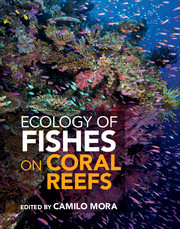Book contents
- Frontmatter
- Contents
- Preface
- Foreword
- List of contributors
- PART I BASIC ECOLOGY
- 1 Sensory biology and navigation behavior of reef fish larvae
- 2 Mission impossible: unlocking the secrets of coral reef fish dispersal
- 3 Recruitment of coral reef fishes: linkages across stages
- 4 Competition in reef fishes
- 5 Predation: piscivory and the ecology of coral reef fishes
- PART II PATTERNS AND PROCESSES
- PART III HUMAN FINGERPRINTS
- PART IV CONSERVATION
- PART V DEBATES AND PARADIGM SHIFTS
- References
- Index
3 - Recruitment of coral reef fishes: linkages across stages
from PART I - BASIC ECOLOGY
Published online by Cambridge University Press: 05 May 2015
- Frontmatter
- Contents
- Preface
- Foreword
- List of contributors
- PART I BASIC ECOLOGY
- 1 Sensory biology and navigation behavior of reef fish larvae
- 2 Mission impossible: unlocking the secrets of coral reef fish dispersal
- 3 Recruitment of coral reef fishes: linkages across stages
- 4 Competition in reef fishes
- 5 Predation: piscivory and the ecology of coral reef fishes
- PART II PATTERNS AND PROCESSES
- PART III HUMAN FINGERPRINTS
- PART IV CONSERVATION
- PART V DEBATES AND PARADIGM SHIFTS
- References
- Index
Summary
Recruitment, or the entry, of young coral reef fishes into benthic populations is essential to population survival, but because larvae typically spend several weeks in the plankton away from the reef environment, understanding the entire process encompassing adult spawning, larval dispersal, and final settlement to the reef has been challenging. Sampling late-stage larvae during settlement has enabled some distinction between preversus post settlement processes. Many reef fish species settle directly to adult reef habitats, others settle to inshore seagrass, mangrove, or hardbottom areas and transition to the reef later in juvenile life. Recruitment of most reef fishes is typically lunar cyclic, with settlement occurring during the darkest half of the lunar cycle. However, biological and physical processes prior to settlement often insert variance into this pattern. Spatial recruitment patterns similarly range from predictable to highly variable depending on the species and system. Post-settlement survivorship is determined by reef-based predation and is frequently non-random and associated with particular early life-history traits. Trait-based selective mortality of young fish is common and has the potential to substantially influence population characteristics. A multi-stage understanding of recruitment is necessary as population modeling becomes increasingly important for resource management and conservation, yet empirical data for critical model parameterizations are still needed.
The recruitment of young is fundamental to the survivorship of any population. For coral reef fishes, this process has the added complexity that the young entering the population may or may not be sourced directly from the population [reviewed in 578, 1295]. Spatial and temporal patterns of reef fish recruitment have been documented for decades, but understanding the mechanisms by which young recruit remains challenging due to the bipartite life cycle of reef fishes and the difficulty of adequately sampling the entire population domain. By definition, coral reef fishes are associated with a benthos that can be spatially patchy. On these reefs, most fishes spawn eggs that hatch into larvae that spend all or a portion of their development at sea, potentially far from natal and settlement populations.
- Type
- Chapter
- Information
- Ecology of Fishes on Coral Reefs , pp. 28 - 33Publisher: Cambridge University PressPrint publication year: 2015
- 9
- Cited by



